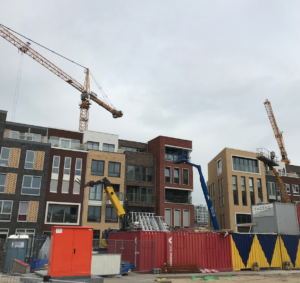The attraction to urban areas means that new houses and workplaces are needed. Building new houses or renovating older housing stock is a natural way for a city to evolve. However, the end products of construction projects are produced at their place of consumption. This means that a multitude of materials and resources need to be delivered to, and removed from, each construction site.
Construction sites
In urban areas, these transports for construction sites are subject to space limitations, environmental demands, accessibility demands and noise restrictions. This has led to a situation where material deliveries to construction sites needs to be coordinated and managed in ways that reduce their impact on the urban transport system and at the same time ensuring efficient construction projects. In essence, construction in urban areas faces two problems; the urban transport problem and the problem of coordinating multiple construction stakeholders.
Construction logistics centres
One way to address these problems is through the use of construction logistics solutions such as terminals (e.g. construction logistics centres) and checkpoints. The aim of both types of solutions is to control and coordinate construction transports.
In the construction industry, these solutions are however, still a rather new phenomenon. This means that how these solutions are perceived by different stakeholders, and the effect the solutions have on material flows and costs, needs to be explored further.
The purpose of the thesis is to explore how construction logistics solutions can be used as a means to coordinate material flows to ensure efficient construction and reduce disturbances on the urban transport system.
Research
To achieve this purpose, the following research questions were addressed by Swedish researcher Mats Janne:
- How are different stakeholders in the construction industry affected by construction logistics solutions?
- How will the use of construction logistics solutions affect material flows and costs in urban construction projects?
To answer the research questions two main methodologies have been used; case study research for the empirical studies and literature reviews for the analysis of the case studies as well as for understanding how supply chain management, logistics, and third-party logistics affects the inter-organizational relationships of the construction industry.

Findings
The main findings of the research are firstly that construction logistics solutions do have a role to play in the coordination of different construction stakeholders. Adding this new node will force construction stakeholders to address coordination issues in order to ensure that material deliveries arrive to construction sites on time. This also implies that new interorganizational relationships will evolve, where communication is key. However, this may not be an easy task as it will call for an attitude adjustment towards a more open and collaborative environment.
Secondly, adding a construction logistics solution can reduce some unnecessary friction between construction stakeholders and third parties. Coordinated material flows can lead to a reduction in the amount of material delivery vehicles that is transported to construction sites, thus reducing some of the congestion in the urban transport system. This will not reduce all friction between construction projects and third parties, but it is a step in the right direction.
Thirdly, a construction logistics solution must come with a set of regulations and a governance strategy from the initiator of the solution. This governance strategy must be clearly stated and communicated to the affected stakeholders. To alleviate animosity towards the solution, flexibility and stakeholder involvement is key. If the directly affected stakeholders are consulted on the function, chances are that they will be more accepting of the solution.
Source: Construction Logistics Solutions in Urban Areas
By Mats Janné of Linköping Studies in Science and Technology.
